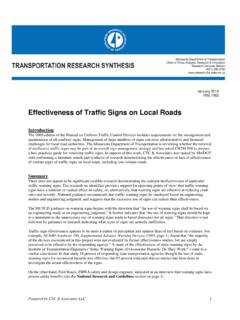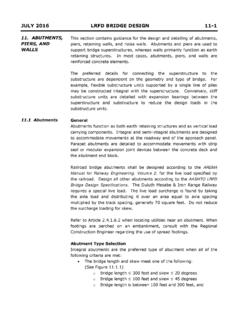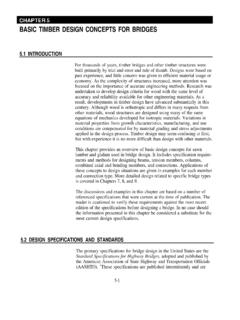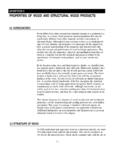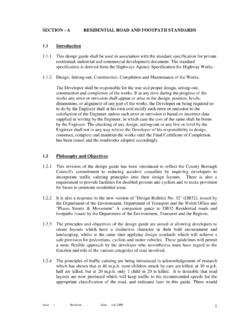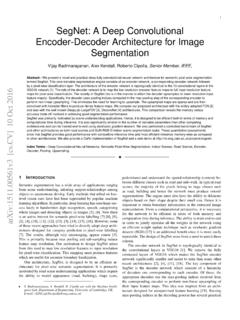Transcription of FHWA Functional Classification Guidelines
1 fhwa Functional Classification Guidelines Concepts, Criteria and Procedures SECTION I - INTRODUCTION. This reference manual includes sections on (1) concepts of Functional highway Classification and Functional system characteristics and (2) suggested procedures for Functional highway Classification in rural, small urban and urbanized areas. The material herein is adapted from two previous fhwa manuals concerned with Functional highway Classification . The relationship of this manual to these previous documents is discussed below. Two nationwide studies of Functional highway Classification were conducted during the period 1969-1971.
2 The first of these, using criteria and procedures specified in the 1968 National Highway Functional Classification Study Manual, called for the Functional Classification of existing (1968) highways. The second study was carried out in accordance with procedures specified in the National Highway- Functional Classification and Needs Study Manual (1970 to 1990) . This latter study used the same Functional classes and basic Functional criteria as the first study, but provided for the Classification to be based on projected 1990 facilities and usage. The Federal-Aid Highway Act of 1973 required the use of Functional highway Classification to update and modify the Federal-aid highway systems by July 1, 1976.
3 This legislative requirement is still effective today. Also a number of States have adapted the Functional classes and criteria from these studies for their own purposes. For both these reasons, a need has developed for a republication of the Functional Classification concepts and criteria that were expressed in the aforementioned manuals, without the reference to specific study requirements that pertained in those manuals. The Functional classes and their characteristics defined in this manual are, for the most part, identical to those in the predecessor manuals.
4 Text has been reworded only to the extent necessary for consistency and clarity and to delete reference to the original studies. The discussion of Functional Classification concepts is taken intact from the earlier of the two manuals. Also included herein is a discussion of suggested Classification procedures for rural, small urban and urbanized areas, which derives from the predecessor manuals, relying largely, in fact, on their original wording. This approach therefore provides first, a description of suggested procedures for classifying an existing network, followed by procedural suggestions for developing an updated or "future year".
5 Classification . Procedures for Functional Classification in urbanized areas should be developed within the framework of the continuing, comprehensive, and cooperative planning process carried out pursuant to Section 134 of Title 23, Code. Section II - Concepts, Definitions, and System Characteristics THE CONCEPT OF Functional Classification . Functional Classification is the process by which streets and highways are grouped into classes, or systems, according to the character of service they are intended to provide. Basic to this process is the recognition that individual roads and streets do not serve travel independently in any major way.
6 Rather, most travel involves movement through a network of roads. It becomes necessary then to determine how this travel can be channelized within the network in a logical and efficient manner. Functional Classification defines the nature of this channelization process by defining the part that any particular road or street should play in serving the flow of trips through a highway network. A schematic illustration of this basic idea is provided in Figure II-1. In the upper diagram, lines of travel desire are shown as straight lines connecting trip origins and destinations.
7 Relative widths of lines indicate relative amounts of travel desire. Relative sizes of circles indicate relative trip generating or attracting power of the places shown. Since it is impractical to provide direct-line connections for every desire line, trips must be channelized on a limited road network in a logical and efficient manner. This can be done as shown in the lower diagram of Figure II-1. Note that the heavy travel movements are directly served or nearly so; and that the lesser ones are channeled into somewhat indirect paths. The facilities shown in the diagram have been labeled local, collector and arterial; terms which are descriptive of their Functional relationships.
8 Note particularly that this hierarchy of Functional types relates directly to the hierarchy of travel distances which they serve. A more complete (though still schematic) illustration of a functionally classified rural network is shown in Figure II-2. Since the cities and larger towns generate and attract a large proportion of the relatively longer trips, the arterial highways generally provide direct service for such travel. The intermediate Functional category, the collectors, serves small towns directly, connects them to the arterial network, and collects traffic from the bottom- level system of local roads, which serves individual farms and other rural land uses.
9 Although the above example has a rural setting, the same basic concepts apply in urban areas as well. A. similar hierarchy of systems can be defined; however, because of the high intensity of land use and travel throughout an urban area, specific travel generation centers are more difficult to identify. In urban areas additional considerations, such as spacing, become more important in defining a logical and efficient network. A schematic illustration of a functionally classified urban street network is shown in Figure II-3. Allied to the idea of traffic channelization is the dual role the highway network plays in providing (1) access to property, and (2) travel mobility.
10 Access is a fixed requirement, necessary at both ends of any trip. Mobility, along the path of such trips, can be provided at varying levels, usually referred to as "level of service." It can incorporate a wide range of elements ( , riding comfort and freedom from speed changes). but the most basic is operating speed or trip travel time. It was pointed out in the discussion of Figure II-1 that the concept of traffic channelization leads logically not only to a Functional hierarchy of systems, but also to a parallel hierarchy of relative travel distances served by those systems.
